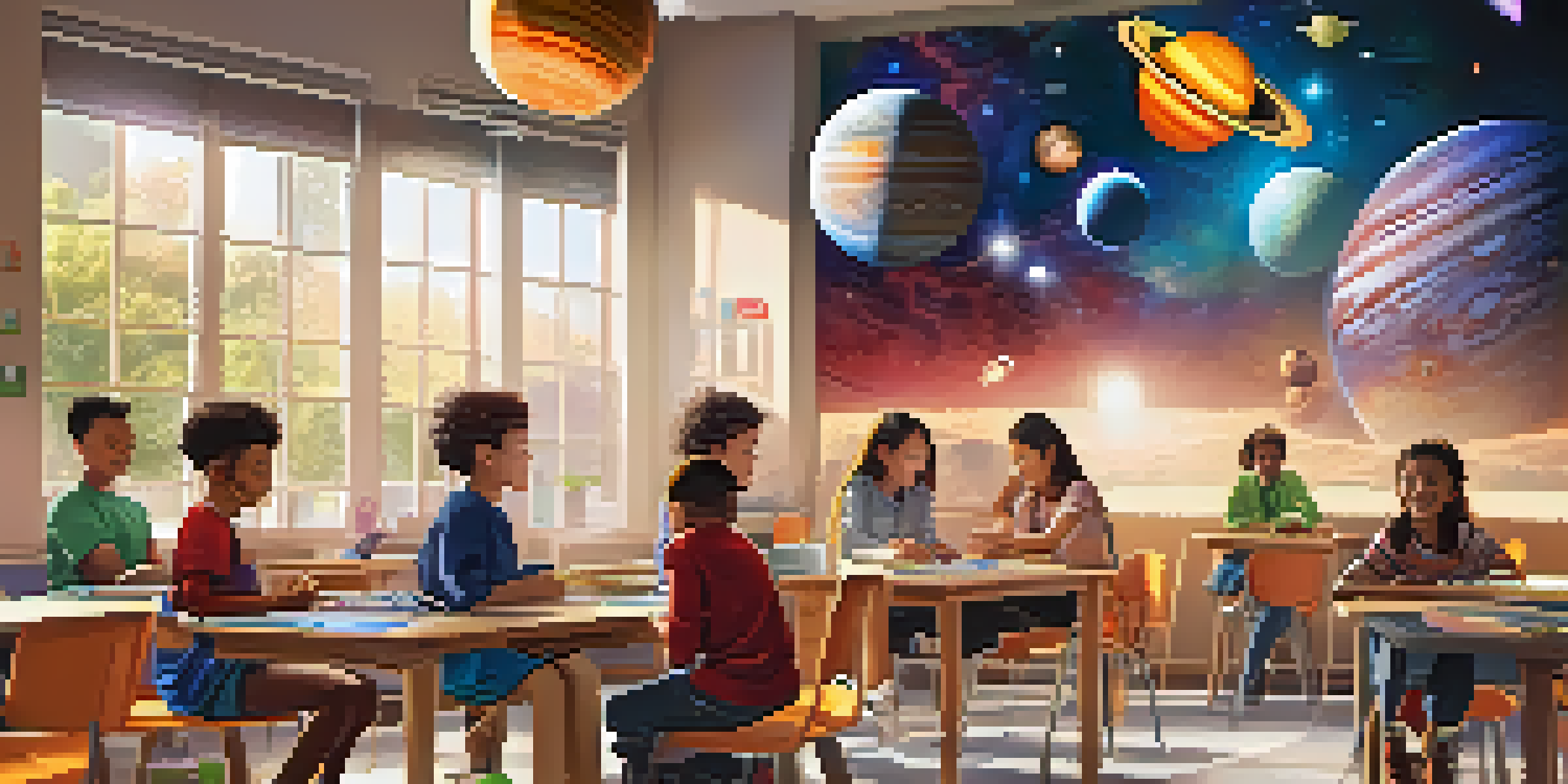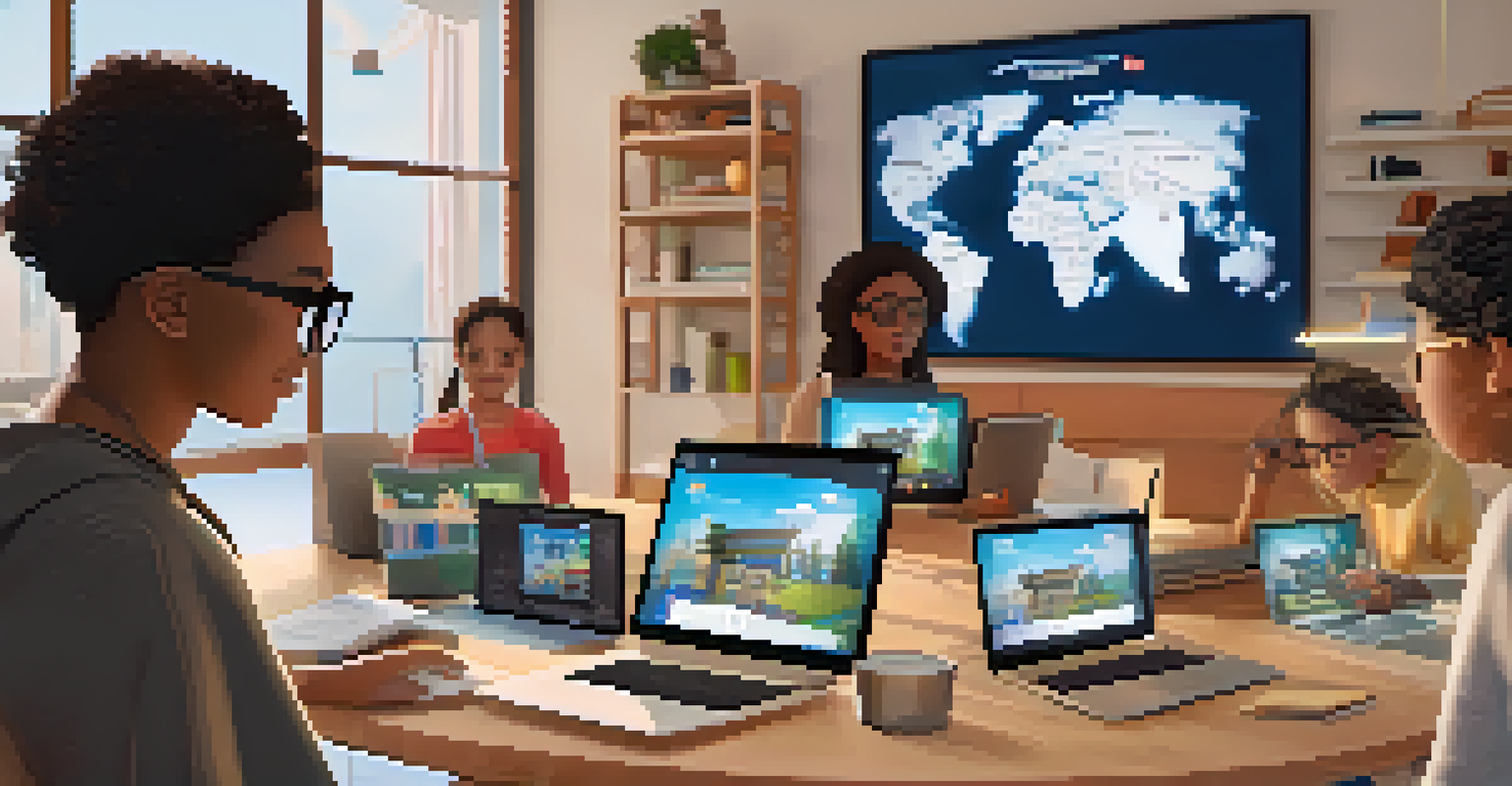The Role of AR in Enhancing Collaborative Learning Spaces

Understanding Augmented Reality in Education
Augmented Reality (AR) is a technology that overlays digital information onto the real world, enhancing our perception of our surroundings. In the context of education, AR can transform ordinary learning experiences into immersive and interactive encounters. Imagine exploring the solar system by seeing planets orbiting your classroom as if they were right there with you.
Technology will not replace great teachers, but technology in the hands of great teachers can be transformational.
This technology bridges the gap between theoretical knowledge and practical application, allowing students to visualize complex concepts in a relatable way. As a result, learners can engage with the material more deeply, fostering a greater understanding of the subject matter. It's not just about seeing information but experiencing it firsthand.
Furthermore, AR tools can be used in collaborative settings, enabling groups of students to work together in a shared environment. This collaborative aspect is vital, as it encourages communication, teamwork, and problem-solving—all essential skills for the modern world.
Fostering Engagement through Interactive Learning
One of the most significant benefits of AR in collaborative learning is its ability to boost student engagement. When learners interact with digital content in real-time, it captures their attention and keeps them motivated. Think about a biology class where students can manipulate a 3D model of a cell, examining its structures up close and personal.

Engagement leads to better retention of information, as students are more likely to remember what they have actively participated in. This hands-on approach to learning transforms the traditional classroom into a dynamic space where curiosity thrives. Plus, students often find it more enjoyable, making them eager to participate.
AR Enhances Engagement in Learning
Augmented Reality captivates students by allowing them to interact with digital content in real-time, boosting motivation and information retention.
In many cases, AR can also facilitate personalized learning experiences. Each student can explore concepts at their own pace, collaborating with peers while still receiving tailored support. This flexibility helps cater to different learning styles and needs, ensuring that everyone has a chance to succeed.
Enhancing Communication and Collaboration Skills
AR tools promote a collaborative atmosphere in educational settings by encouraging communication among students. When working on AR projects, learners must discuss their findings, share insights, and help each other navigate challenges. This kind of interaction not only enhances their understanding of the subject matter but also strengthens their social skills.
The future of education is not just about technology, but about how we use it to create engaging and inclusive learning experiences.
Communication is key in any collaborative effort, and AR provides a platform for students to express their ideas visually and verbally. For instance, during a group project, one student might use AR to present a visual representation of their research, prompting discussion and feedback from peers. This creates a richer learning environment.
Moreover, students learn to respect diverse perspectives as they work together, fostering a sense of community. The collaborative nature of AR encourages students to listen and respond to one another, which is crucial for their personal and academic growth.
Bridging the Gap Between Virtual and Physical Worlds
AR uniquely blends the virtual and physical realms, allowing students to explore real-world scenarios enriched with digital overlays. This integration is especially beneficial in collaborative learning, as it enables groups to engage with tangible objects while accessing additional information. For example, students might study a historical site through AR, seeing historical figures and events come to life around them.
By bridging these worlds, AR helps students draw connections between theoretical concepts and real-life applications. It makes learning relevant, showing them how their studies apply beyond the classroom. This relevance can spark interest in subjects that may otherwise seem distant or abstract.
Fosters Collaboration and Communication
AR tools promote teamwork by encouraging students to discuss findings and share insights, enhancing both their understanding and social skills.
Furthermore, this technology can enhance field trips or on-site learning experiences, making them more interactive and informative. Students can gather data and share their findings with peers, enriching the learning experience and transforming how they perceive the world around them.
Facilitating Remote Collaboration and Learning
In today's digital age, remote collaboration is becoming increasingly important, and AR can bridge the gap for students who are not physically together. With AR applications, learners can interact with the same virtual objects and environments, regardless of their location. This capability is particularly valuable in a world where online learning is on the rise.
Imagine students from different parts of the globe working together on a science project, using AR to visualize their experiments in real-time. This not only enhances their learning experience but also teaches them to work in diverse teams, a skill essential for future careers. They learn to navigate technology and communicate effectively across distances.
Remote collaboration through AR can also help educators connect with students in various regions, providing equal access to quality educational resources. This democratization of learning ensures that geography does not hinder a student's ability to engage with their peers or access innovative learning tools.
The Role of AR in Inclusive Learning Environments
Inclusivity is a crucial aspect of modern education, and AR can play a significant role in making learning accessible for all students. The interactive nature of AR can cater to different learning styles and abilities, helping diverse learners engage with the content effectively. For instance, visual learners may benefit from AR's rich graphics, while kinesthetic learners can interact with 3D objects.
Moreover, AR can provide additional support for students with disabilities by offering alternative methods to access information. For example, an AR application might provide audio descriptions or visual cues to help students with visual impairments understand complex concepts. This ensures that everyone has the opportunity to participate and learn.
Supports Inclusive Learning Environments
AR accommodates diverse learning styles and abilities, ensuring all students can engage with content effectively and fostering empathy among peers.
By fostering an inclusive environment, AR helps students develop empathy and understanding toward one another. As they collaborate and learn together, they build relationships and appreciate the strengths that each individual brings to the table.
Challenges and Considerations in Implementing AR
While the benefits of AR in collaborative learning are clear, there are challenges to consider when implementing this technology in educational settings. One significant hurdle is the cost of AR tools and resources, which can be a barrier for some institutions. Educators must assess their budget and resources before diving into AR integration.
Additionally, teachers may need training to effectively utilize AR in their classrooms. A lack of familiarity with the technology can lead to underutilization or ineffective implementation. Providing professional development opportunities is essential to ensure educators feel confident and prepared to incorporate AR into their teaching strategies.

Lastly, it's important to consider the balance between technology and traditional learning methods. While AR can enhance the learning experience, it shouldn't replace essential hands-on activities or face-to-face interactions. Finding the right blend is key to maximizing the benefits of AR while maintaining a well-rounded educational approach.